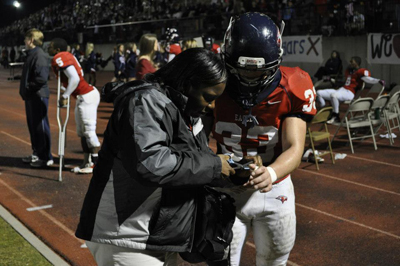May 3, 2017Right from Wrong

To get to the point of providing athletic medical care, athletic training professionals must go through many steps. Traditionally, these steps include having the required content knowledge of assessment and care of injuries, the acquired hands-on skills to detect a myriad of injuries, and the ability to document assessment findings and make referrals to health care providers. However, the first critical step in providing effective athletic medical care is to apply ethical standards in making decisions that ensure the long-term well-being of the athlete. Ethics is knowing right from wrong and the commitment to do what is right, good, and proper.
As a medical profession, athletic training has established a “social contract” with the public. A contract has both expectations and obligations based on trust and integrity that need to be met by the two parties. Some of the elements that the public bestows upon the athletic training profession include trust, autonomy to make medical judgments, respect, and status. In turn, the athletic training profession provides the public with accountability, altruistic behavior, competence in care, and self-regulation of professional practice. Athletic training has fulfilled its social contract with the public through its established professional preparation in knowledge and skills per the Commission on Accreditation of Athletic Training Education, the Board of Certification, and 49 states that regulate the practice of athletic training within their state. The organization that has been recognized as the governing body of athletic training by the American Medical Association is the NATA. Truly, the certified and licensed athletic trainer is a medical professional and is prepared to provide medical care to active people and athletes at every level.
It is easy to get caught up in making judgments in order to fulfill an archaic belief that an athletic trainer’s effectiveness should be judged on how fast an athlete returns from injury… But it is far more appropriate for the athletic trainer to be judged on the quality of care they provide.
In the competitive nature of athletics, there are many influences that pose significant ethical considerations for those providing athletic medical care. It is easy for the athletic trainer to get caught up in making judgments on medical care in order to fulfill an archaic belief that an athletic trainer’s effectiveness should be judged on how fast an athlete returns from injury or by how many team members are participating at any given time.
We’ve all heard the quotes: “He/she keeps them playing,” “Great job this year. We only had a few lost days of activity,” “Don’t worry, we have a great medical staff, and they will have the athlete ready for next week’s game.” These expectations raised by coaches, administrators, the media, and even athletes and their parents can create an ethical dilemma for the athletic trainer, especially when an inappropriate request is being made that may put the athlete’s long-term well-being at risk.
It is far more appropriate for the athletic trainer to be judged on the quality of care they provide for the long-term well-being of the patient/athlete. The social contract we have with the public includes altruistic behavior and competence in care. Making judgments on appropriate and inappropriate risk to long-term well-being in returning an athlete back to participation has more to do with ethics than medicine in most cases.
Let’s examine a common scenario as an example of how ethics are challenged for the athletic trainer:
A starting intercollegiate student-athlete sustains a concussion in a soccer game prior to the start of their sport’s playoffs the following week. Given that the return-to-play process starts after all symptoms have resolved, neurocognitive and balance testing is back to baseline (per NCAA recommendations), and the athlete has resumed coursework in the return-to-learn protocol of the school’s concussion management plan, there is little time for the athlete to appropriately return to a contact sport before the first playoff game. While it may be possible for a safe return by the playoff game, the concussion management plan must align tightly — with concussion symptoms resolving and baseline retesting being completed by the day after the injury in order for the athlete to play seven days later. Does the athletic trainer skip steps? Or do they permit the return-to-play protocol to proceed to get the athlete back for the first playoff game, even if the athlete reports or exhibits concussion symptoms?
There are many scenarios similar to the one above that challenge the ethics of the athletic trainer. The NATA has a Code of Ethics that provides guidance for the ethical behavior of the athletic training professional. As Chair of the NATA Committee on Professional Ethics, I am privileged to work with a committed group of athletic training professionals who are dedicated to upholding ethical standards and educating the NATA membership and the public with the Code of Ethics.
The NATA Code of Ethics can be found here.


